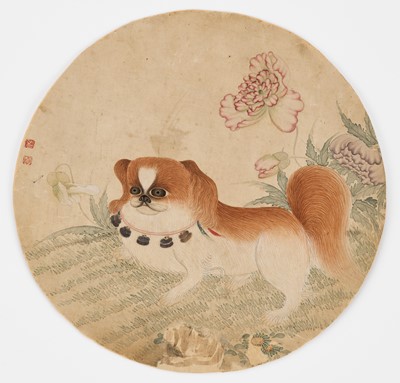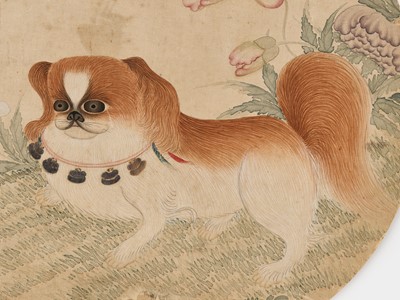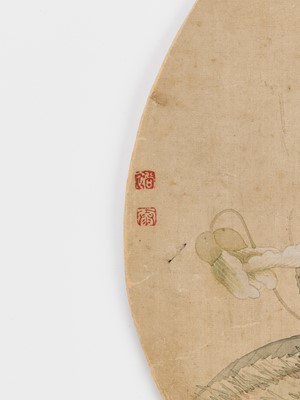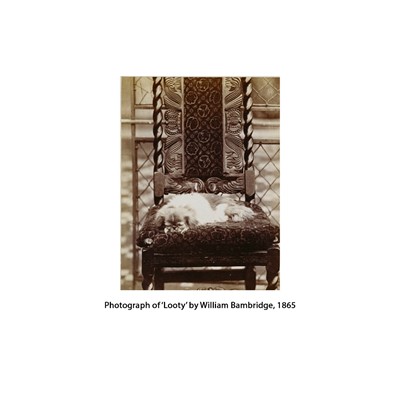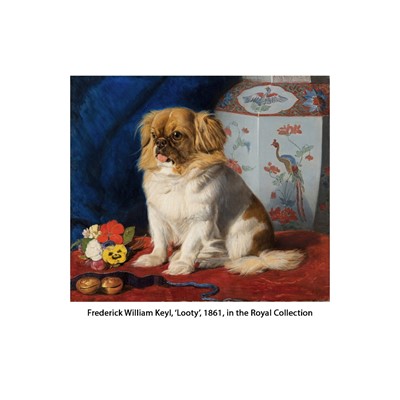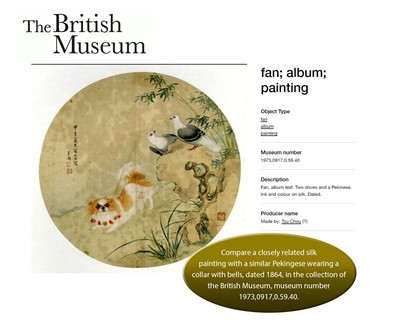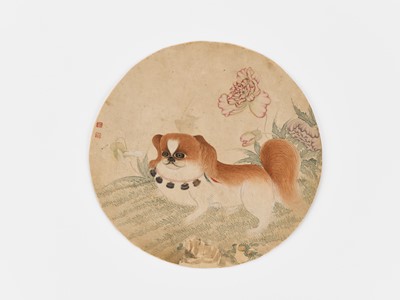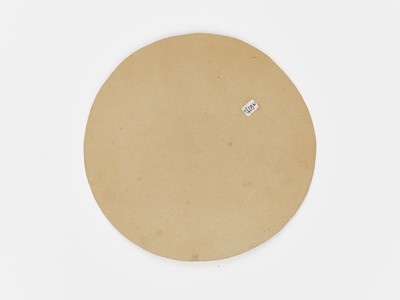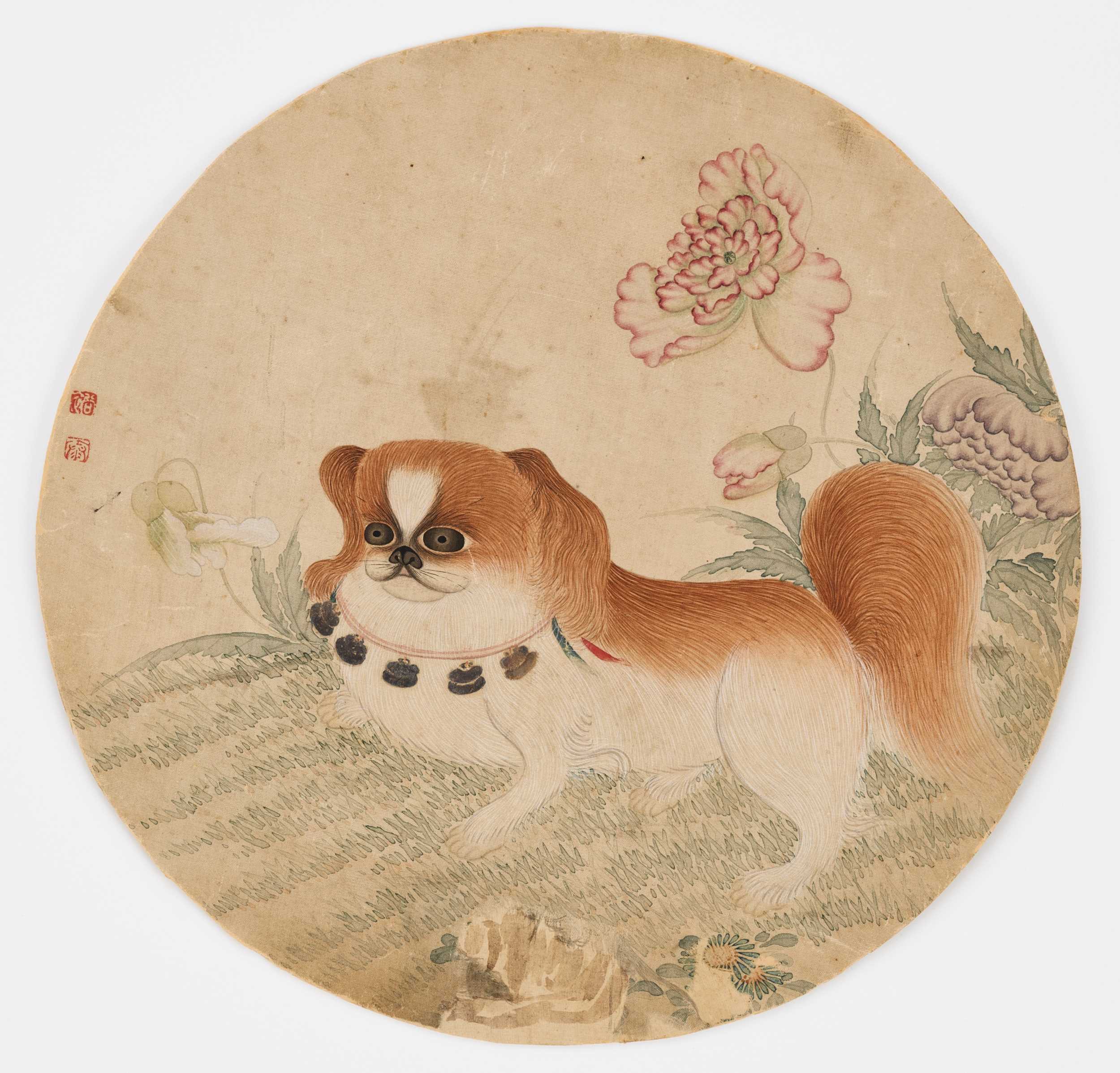16th Oct, 2021 10:00
TWO-DAY AUCTION - Fine Chinese Art / 中國藝術集珍 / Buddhism & Hinduism
528
‘PEKINGESE’, QING DYNASTY
清代《北京哈巴狗》
Sold for €2,022
including Buyer's Premium
China, mid-19th century. Ink and watercolors on silk, laid down on paper. Depicting a Pekingese wearing a collar with five bells attached and walking on grass surrounded by peony buds and blossoms.
Inscriptions: Two seals.
Provenance: From a French private collection. Inventory label ‘1829 w’ to back.
Condition: Good condition with old wear, minor tears and creases, small losses, loose threads, and soiling.
Dimensions: Diameter 27 cm
The Pekingese breed originated in China and could only be owned by members of the Chinese Imperial Palace. A consort of the Daoguang Emperor, Lady Chang of the prominent Manchu Heseri clan, was a lover of dogs and particularly enamored with Pekingese. According to Geoffrey R. Sayer (Tao Ya or Pottery Refinements, London, 1959, page 123, no. 722) “Cheng Miao [the Daoguang Emperor] was fond of pigeons, his exalted concubine was fond of little dogs.”
During the Second Opium War, in 1860, the Old Summer Palace in Beijing was occupied by a contingent of British and French troops. The Xianfeng Emperor had fled with all of his court to Chengde. However, the elderly Consort Chang remained. When the British and French troops entered, she committed suicide. She was found with her five Pekingese. They were removed by the Allies before the Summer Palace was burnt to the ground.
John Hart Dunne, Captain of the 99th Regiment of Foot, who participated in the Second Opium War and ransacked the Summer Palace, gifted one of these Pekingese to Queen Victoria in April 1861, writing to her in a letter: “This little dog was found by me in the Palace of Yuan-Ming-Yuan near Pekin on the 6th of October 1860. It is supposed to have belonged to either the Empress, or one of the ladies of the Imperial Family. It is a most affectionate and intelligent little creature – it has always been accustomed to being treated as a pet and it was with the hope that it might be looked upon as such by Her Majesty and the Royal Family that I have brought it from China.” (David Matthews, Jo Lee Magazine, November 2002, page 18). Rather insensitively, the Queen and first owner of a Pekingese in the West, named her new pet ‘Looty’.
Literature comparison: Compare a closely related silk painting with a similar Pekingese wearing a collar with bells, dated 1864, in the collection of the British Museum, museum number 1973,0917,0.59.40.
清代《北京哈巴狗》
中國, 十九世紀中期。絹本設色。一直北京哈巴狗戴著鈴鐺,在院子裏嬉戲,周圍鮮花盛開。
款識:兩枚鈴印
來源:法國私人收藏,背面收藏標簽“1829 w“。
品相:狀況良好,磨損、輕微撕裂和摺痕、小缺失、絲綫鬆動和污跡。
尺寸:直徑 27 厘米
China, mid-19th century. Ink and watercolors on silk, laid down on paper. Depicting a Pekingese wearing a collar with five bells attached and walking on grass surrounded by peony buds and blossoms.
Inscriptions: Two seals.
Provenance: From a French private collection. Inventory label ‘1829 w’ to back.
Condition: Good condition with old wear, minor tears and creases, small losses, loose threads, and soiling.
Dimensions: Diameter 27 cm
The Pekingese breed originated in China and could only be owned by members of the Chinese Imperial Palace. A consort of the Daoguang Emperor, Lady Chang of the prominent Manchu Heseri clan, was a lover of dogs and particularly enamored with Pekingese. According to Geoffrey R. Sayer (Tao Ya or Pottery Refinements, London, 1959, page 123, no. 722) “Cheng Miao [the Daoguang Emperor] was fond of pigeons, his exalted concubine was fond of little dogs.”
During the Second Opium War, in 1860, the Old Summer Palace in Beijing was occupied by a contingent of British and French troops. The Xianfeng Emperor had fled with all of his court to Chengde. However, the elderly Consort Chang remained. When the British and French troops entered, she committed suicide. She was found with her five Pekingese. They were removed by the Allies before the Summer Palace was burnt to the ground.
John Hart Dunne, Captain of the 99th Regiment of Foot, who participated in the Second Opium War and ransacked the Summer Palace, gifted one of these Pekingese to Queen Victoria in April 1861, writing to her in a letter: “This little dog was found by me in the Palace of Yuan-Ming-Yuan near Pekin on the 6th of October 1860. It is supposed to have belonged to either the Empress, or one of the ladies of the Imperial Family. It is a most affectionate and intelligent little creature – it has always been accustomed to being treated as a pet and it was with the hope that it might be looked upon as such by Her Majesty and the Royal Family that I have brought it from China.” (David Matthews, Jo Lee Magazine, November 2002, page 18). Rather insensitively, the Queen and first owner of a Pekingese in the West, named her new pet ‘Looty’.
Literature comparison: Compare a closely related silk painting with a similar Pekingese wearing a collar with bells, dated 1864, in the collection of the British Museum, museum number 1973,0917,0.59.40.
清代《北京哈巴狗》
中國, 十九世紀中期。絹本設色。一直北京哈巴狗戴著鈴鐺,在院子裏嬉戲,周圍鮮花盛開。
款識:兩枚鈴印
來源:法國私人收藏,背面收藏標簽“1829 w“。
品相:狀況良好,磨損、輕微撕裂和摺痕、小缺失、絲綫鬆動和污跡。
尺寸:直徑 27 厘米
Zacke Live Online Bidding
Our online bidding platform makes it easier than ever to bid in our auctions! When you bid through our website, you can take advantage of our premium buyer's terms without incurring any additional online bidding surcharges.
To bid live online, you'll need to create an online account. Once your account is created and your identity is verified, you can register to bid in an auction up to 12 hours before the auction begins.
Intended Spend and Bid Limits
When you register to bid in an online auction, you will need to share your intended maximum spending budget for the auction. We will then review your intended spend and set a bid limit for you. Once you have pre-registered for a live online auction, you can see your intended spend and bid limit by going to 'Account Settings' and clicking on 'Live Bidding Registrations'.
Your bid limit will be the maximum amount you can bid during the auction. Your bid limit is for the hammer price and is not affected by the buyer’s premium and VAT. For example, if you have a bid limit of €1,000 and place two winning bids for €300 and €200, then you will only be able to bid €500 for the rest of the auction. If you try to place a bid that is higher than €500, you will not be able to do so.
Online Absentee and Telephone Bids
You can now leave absentee and telephone bids on our website!
Absentee Bidding
Once you've created an account and your identity is verified, you can leave your absentee bid directly on the lot page. We will contact you when your bids have been confirmed.
Telephone Bidding
Once you've created an account and your identity is verified, you can leave telephone bids online. We will contact you when your bids have been confirmed.
Classic Absentee and Telephone Bidding Form
You can still submit absentee and telephone bids by email or fax if you prefer. Simply fill out the Absentee Bidding/Telephone bidding form and return it to us by email at office@zacke.at or by fax at +43 (1) 532 04 52 20. You can download the PDF from our Upcoming Auctions page.
How-To Guides
How to Create Your Personal Zacke Account
How to Register to Bid on Zacke Live
How to Leave Absentee Bids Online
How to Leave Telephone Bids Online
中文版本的操作指南
创建新账号
注册Zacke Live在线直播竞拍(免平台费)
缺席投标和电话投标
Third-Party Bidding
We partner with best-in-class third-party partners to make it easy for you to bid online in the channel of your choice. Please note that if you bid with one of our third-party online partners, then there will be a live bidding surcharge on top of your final purchase price. You can find all of our fees here. Here's a full list of our third-party partners:
- 51 Bid Live
- EpaiLive
- ArtFoxLive
- Invaluable
- LiveAuctioneers
- the-saleroom
- lot-tissimo
- Drouot
Please note that we place different auctions on different platforms. For example, in general, we only place Chinese art auctions on 51 Bid Live.
Bidding in Person
You must register to bid in person and will be assigned a paddle at the auction. Please contact us at office@zacke.at or +43 (1) 532 04 52 for the latest local health and safety guidelines.
